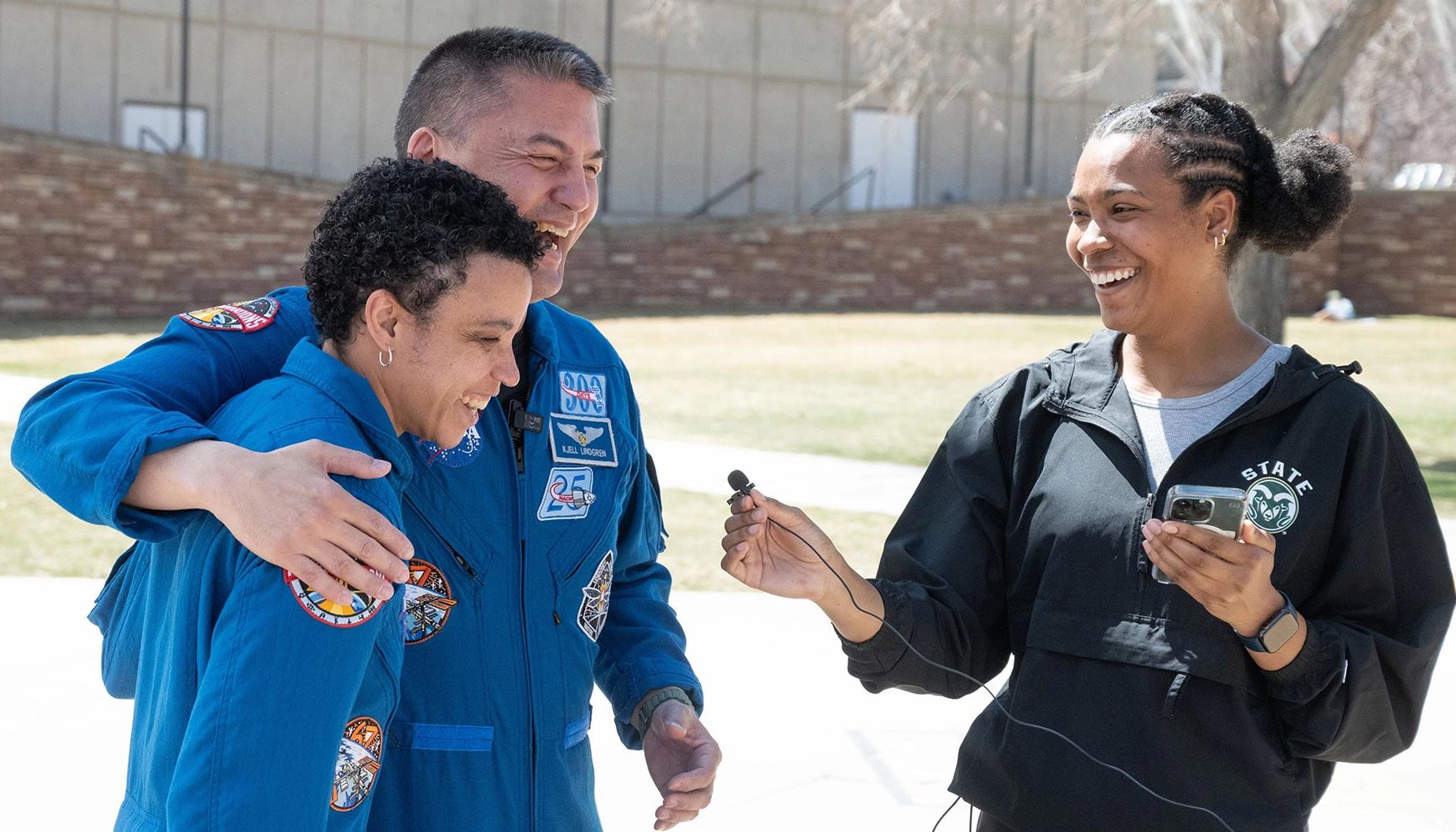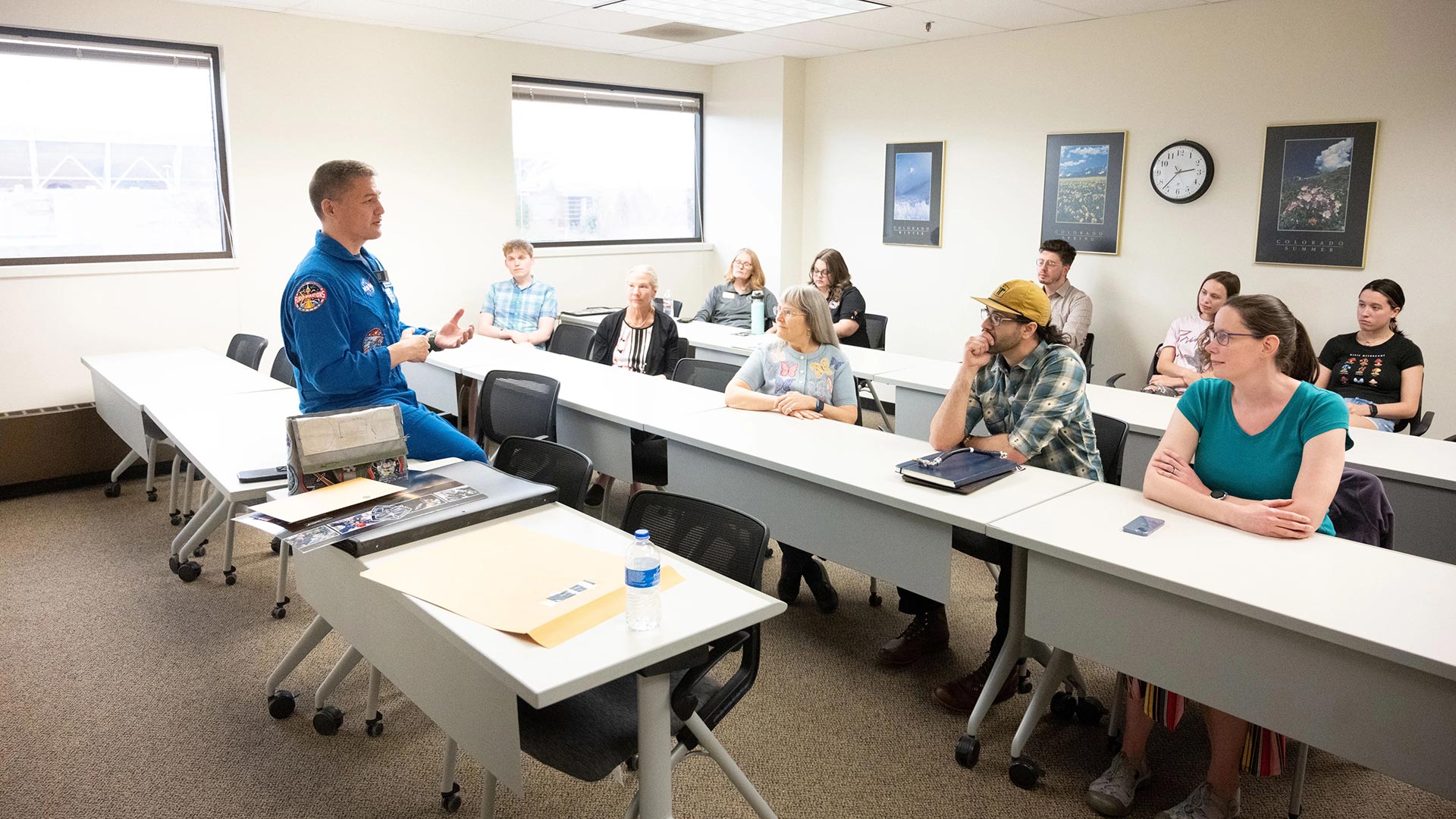Highlights from the April 12 visit to campus by astronauts Kjell Lindgren and Jessica Watkins.
Watch the full keynote.
While aboard the International Space Station in 2022, NASA astronauts Kjell Lindgren and Jessica Watkins participated in over 250 scientific experiments. One of their favorites? Growing tomatoes.
The 2022 NASA Commercial Crew-4 mission included testing whether hydroponic and aeroponic techniques could maintain plant life on board. Ending up with peas, carrots, radishes, wheats and grasses, the astronauts’ crowning achievement was a handful of cherry tomatoes, whose delicious-looking red ripeness peaked … right as they were scheduled to return to Earth after six months in space.
“Our follow-on crew got to eat the cherry tomatoes,” said Lindgren, a 1996 alumnus of Colorado State University. “If there was ever any regret about our mission, it’s that we did not get to eat those.”
Stories like these held the rapt attention of a large crowd gathered April 12 at the Translational Medicine Institute to hear a keynote address from the astronauts, who visited CSU to recount their experiences as part of the elite group of humans who can say they’ve ever left the planet.
Their talk was titled “One Health, One Planet: NASA astronauts share their view from space.”
The visit was hosted by the College of Veterinary Medicine and Biomedical Sciences, from which Lindgren earned a master’s degree in cardiovascular physiology in 1996.

NASA astronauts Jessica Watkins and Kjell Lindgren deliver their keynote address April 12 at the Translational Medicine Institute.
Experiencing weightlessness
Among the stories shared by Watkins — of Lafayette, Colorado, and the first Black woman to serve on an International Space Station long-term mission — was the learning curve of being in a weightless environment.
“It takes some time to get used to zero gravity and to learn how to float around and use different handrails appropriately to move yourself along and make sure you’re inputting the right amount of force, so that you’re not pushing off and going clear all the way to the back of the station,” said Watkins, a geologist by training. “But luckily we have our friends who’ve been to space before and can help us learn how to maneuver in zero-G.”
By the way – did you know that prolonged periods of weightlessness are extremely hard on the human body? It’s like lying flat in bed for six months, which results in cardiovascular deconditioning and loss of bone mineral density and muscle strength, Lindgren told the audience. That’s why astronauts spend over two hours a day on exercise bikes, treadmills and weight-bearing equipment, just to maintain their bone health and muscle strength to prepare to return home.
There are other ways spaceflight is tough on human physiology, which astronauts like Lindgren and Watkins are helping future flyers understand. During their Commercial Crew-4 mission, they not only conducted science but were scientific subjects themselves, submitting to blood and fluid samples to see how their bodies were responding to microgravity.
Beyond the groundbreaking science that the astronauts participated in, the sheer experience of seeing Earth from 250 miles above it was something they’ll never forget. The International Space Station contains a cupola with seven windows that allow the astronauts a breathtaking view of our planet rotating below, Watkins said.
“What’s really neat is being able to see Earth from that kind of orbital perspective and marry that with our ground or in-situ perspective, in a very similar way to how we plan on doing science on the lunar surface here in the near future,” Watkins said.
Upcoming Artemis missions
Lindgren and Watkins are teammates supporting NASA’s ongoing Artemis mission to the moon. Artemis I was an uncrewed mission that sent the Orion spacecraft beyond the moon and back. Artemis II will be a crewed mission – whose members were announced April 3 – consisting of a lunar flyby and return to Earth in 2024. After that will come Artemis III, currently planned for 2025, which is set to mark humanity’s first steps on the lunar surface in more than 50 years.
Looking out at the expanse of space, participating in science that will further humankind’s reach into the universe, were all beautiful things to see and experience during their 170 days in space, the astronauts said.
But the most beautiful sight of all, when preparing to return to Earth after hurtling at 17,500 miles per hour through the atmosphere? “Four good parachutes … so you know you’re going to slow down to a safe speed to splash down,” Watkins said.
Crew-4 splashed safely down in the Atlantic Ocean – the first crew to do so since Apollo 9 – on Oct. 14.
As part of their visit to campus, Lindgren and Watkins participated in a rapid-fire Q&A on TikTok.
@coloradostateuniversity “What does space smell like? And other questions we had for CSU alum & astronaut Kjell Lindgren & Colorado astronaut Jessica Watkins. More in bio 🔗
The astronauts also visited with students and toured labs.
Photos by John Eisele/Colorado State University




Watch the full keynote.